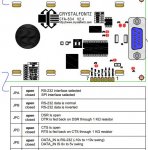Hi,
I have an CFA634-YFH-KS LCD, hardware 3.3, with RS232 serial interface, and I am connecting it to an embedded system, when I connect the Data In pin of the expansion port J2, it shows nothing the LCD, but when it connects with the serial cable to the cftest if works.
The "DATA IN" pin of the expansion port J2 does not receive serial format rs232 ????
Previously I had a cfa634 version 2.4 and if it worked when I entered data rs232 by the "DATA IN" pin of the expansion port J2.
Best regards
I have an CFA634-YFH-KS LCD, hardware 3.3, with RS232 serial interface, and I am connecting it to an embedded system, when I connect the Data In pin of the expansion port J2, it shows nothing the LCD, but when it connects with the serial cable to the cftest if works.
The "DATA IN" pin of the expansion port J2 does not receive serial format rs232 ????
Previously I had a cfa634 version 2.4 and if it worked when I entered data rs232 by the "DATA IN" pin of the expansion port J2.
Best regards
Looking for additional LCD resources? Check out our LCD blog for the latest developments in LCD technology.


